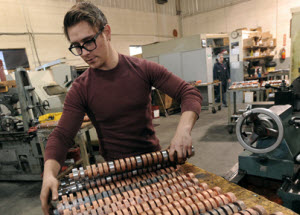Is shortage due to skills or wages?
Steve Lowe Jr. is scrambling to find more than a dozen skilled machinists, experienced engineers and laborers after his company recently won a multimillion-dollar contract to build giant camshafts for diesel locomotive engines.
He said he’s sought out state work force agencies, local community colleges and employment agencies in seeking the workers he needs to start camshaft production this summer.
Lowe said he even looked into hiring foreign workers through the federal government’s controversial H-1B visa program, which allows workers from other countries to work temporarily in the United States.
“To date, I have found no one,” said Lowe, president of LSM Systems Engineering in Waterford, north of Detroit.
Melissa Hull, engineering and production coordinator at American Tooling Center located in Grass Lake, east of Jackson, tells a similar story.
Business is booming, but the company is having difficulty attracting enough machinists, tool-and-die journeymen, and computer numerical control machine programmers to keep up.
“We’re swamped, said Melissa Hull, the company’s engineering and production coordinator. “We’re running 10-hour shifts a day, six days a week.”
That’s mostly great news after a decade in which Michigan lost about 468,000 manufacturing jobs — more than half of all manufacturing jobs in the state -- as automakers, office furniture manufacturers and others struggled to survive the worst stretch of economic decline since the Great Depression.
But industry executives say an improving economy and a surprising comeback of manufacturer have left them struggling to find enough workers to take full advantage of the resurgence.
“The tables have been flipped,” Lowe said. “Two years ago we were just trying to keep the lights on. Now we’re trying to figure how we’re going to find the people we need to do all the work we have.”
Shortage visible, causes aren’t so clear
Other industries, including information technology and health care, also are reporting difficulty in finding the kinds of workers they need. But the labor shortages appear to be most pronounced in manufacturing.
Some economists are skeptical that there is a true labor shortage in manufacturing, noting Michigan’s unemployment rate is still high at 8.9 percent and that most manufacturing wages are not rising.
“Manufacturing wages have been flat overall,” said George Erickcek, a regional economist at the Upjohn Institute for Employment Research in Kalamazoo. “That leads to questions about whether there is a talent gap in the state.”
Erickcek and other experts say if there were a true labor shortage in manufacturing, employers would be forced to boost wages to attract workers. For the most part, that’s not happening.
Manufacturing wages in the state have barely budged in the past four years, rising to an average $1,046.61 a week in December from $1,041.11 in 2008, according to the Bureau of Labor Statistics.
Adjusted for inflation, the average weekly manufacturing wage in Michigan has fallen $63.64 since 2008.
Manufacturers say stiff, low-cost global competition has kept a lid on wages. But they say the industry still offers decent money for the thousands of Michigan students who do not go on to a four-year university, but who have some education or skills training beyond high school.
Too many of those young people are taking dead-end jobs in shopping malls, restaurants and other retail outlets when they could be entering better-paying careers in manufacturing, some say.
“We train our youth to work in service-related industries versus making goods,” Lowe said. “We’re more of a consumer nation, rather than a producing nation.”
Plant floor jobs at American Tooling pay from $12 an hour for an entry-level machinist to around $24 for a journeyman tool-and-die maker.
“You have to be willing to put in the time (for training),” Hull said. “And you need to prove yourself for the first 90 to 120 days.
“There’s an attitude out there that ‘I made $25 to $30 an hour at a plant that closed and I’m not going to accept anything less,’” she said.
Some observers say manufacturers share much of the blame for the shortage of skilled workers they now face.
Factories have long had the reputation as being dirty, depressing places in which to work. Many employers cut wages and laid off workers throughout the 2000s, reinforcing manufacturer’s reputation as an unstable industry.
“A decade is a long time to talk about manufacturing when it’s all negative,” said Bob Sherer, director of the Michigan Workforce Development Agency’s manufacturing cluster.
Other experts say employers are hunting for “unicorns” -- job candidates with qualifications far beyond what is required to do the work.
Manufacturers also cut training and apprenticeship programs, which dried up the pipeline of future workers. High schools dropped vocational education programs and some community colleges cut back on skilled trades curriculums.
Many of those who were laid off during Michigan’s “lost decade” left the state, found other work or retired.
“Some who left don’t want to come back. They’ve been burned too many times,” Sherer said. “(The upswing in hiring) has happened before in Michigan.
“But they don’t realize that it’s an unbelievably good time to get back into manufacturing,” he said.
Manufacturing propels job growth
The state has added about 50,000 manufacturing jobs in the current recovery, representing more than 40 percent of all new jobs in the state.
But growth in manufacturing employment is likely to slow from 16,000 new jobs last year to 10,000 new jobs this year and 13,000 new manufacturing jobs in 2014, according to a University of Michigan forecast.
Still, manufacturing will be responsible for 25 percent of all new jobs in the state over the next two years, the U-M forecast said.
Employers aren’t just looking to grow their staffs to meet rising demand. They’re also faced with having to replace large segments of their work forces that are nearing retirement.
“Any shop you go into in Southeast Michigan, the average age is in the 50s,” said Bill Rayl, executive director of the Jackson Area Manufacturers Association.
“Companies tell me that 50 percent to 60 percent of their work forces are eligible for retirement,” he said. “They don’t have a plan if those folks walk out the door.”
Success: The DIY approach
Faced with severe shortages of machinists, welders and machine programmers, more companies have started training programs to develop new workers.
And some have started to inch up salaries, said Annette Norris, program manager at JAMA’s Academy for Manufacturing Careers.
“There’s a big perception that manufacturing doesn’t exist any more in the United States and that it’s all gone overseas,” she said. “That’s so untrue.”
Another misconception about manufacturing is that factories are dirty and dangerous, Norris said.
“Some of the shops are so clean, you can eat off the floor,” she said. “They do pay well and you can earn a living.”
Erickcek said manufacturing wages vary widely by region and industry segment.
The average manufacturing wage for the highest-skilled workers in the Grand Rapids area fell from $75,000 in 2007 to $66,000 in 2011, the latest data available.
But during the same period, the wages for the highest-skilled manufacturing workers in Kalamazoo rose from $57,000 to $65,000, Erickcek said.
The difference in wages between the two areas may have been a result of declining wages in Grand Rapids’ auto and office furniture segments, and rising wages in Kalamazoo’s pharmaceutical and medical device industries, he said.
State tweaks its training programs
State work force officials have revamped job training programs in the face of employers’ immediate need for workers, particularly in manufacturing, health care and information technology.
Former Gov. Jennifer Granholm’s “No Worker Left Behind” program trained displaced workers and others for opportunities in growing industries. But officials said it was a costly program that too often didn’t result in participants landing jobs, in part because Michigan’s economy was still shrinking.
“In the previous administration, the focus was on getting as many people as possible in training for in-demand occupations,” said Gary Clark, director of talent development services at the state Workforce Development Agency.
But that training didn’t always line up with actual job openings because the state didn’t know enough about the actual job requirements to provide the right training.
For instance, a job seeker might have trained to be a welder, but might not have learned the specific welding skill among many types of welding that an employer required.
“Now we’re meeting with specific industry groups and employers to find out exactly what they need,” Clark said. “Once we get an idea of what the actual jobs require, we can get people trained for those jobs. “We’re developing demand-driven work force programs.”
The state is continuing to deliver job training assistance through 100 Michigan Works! service centers. Clark said the state is required to administer job-training programs through the centers under a 2006 state law.
But state officials are faced with trying to meet the demand for more training with fewer dollars. Most of the state’s job-training money comes from the federal government, which has slashed training funds in recent years.
Appropriations to Michigan from the federal Workforce Investment Act have fallen nearly 55 percent, from $243 million in 2008 to $110 million in the current fiscal year.
Even job training for veterans has been slashed despite all of the talk of trying to help them make the transition from the battlefield to the workplace. Michigan is receiving $5.5 million in federal funds this year to train veterans, down about $600,000 from 2011.
Congress has not reauthorized the Workforce Investment Act in years. Instead, states have received training dollars through budget continuations, which some fear could end because of various austerity measures being considered by Congress.
“The big thing for us is that the federal government reauthorize the Workforce Investment Act,” said Sarah Hartzler, president of the South Central Michigan Works! office in Hillsdale.
Her agency works with American Tooling Center and other Jackson area-companies to help them find and train workers they need.
“Reauthorization will have a direct impact on the amount of training we can provide,” she said.
Business Watch
Covering the intersection of business and policy, and informing Michigan employers and workers on the long road back from coronavirus.
- About Business Watch
- Subscribe
- Share tips and questions with Bridge Business Editor Paula Gardner
Thanks to our Business Watch sponsors.
Support Bridge's nonprofit civic journalism. Donate today.
See what new members are saying about why they donated to Bridge Michigan:
- “In order for this information to be accurate and unbiased it must be underwritten by its readers, not by special interests.” - Larry S.
- “Not many other media sources report on the topics Bridge does.” - Susan B.
- “Your journalism is outstanding and rare these days.” - Mark S.
If you want to ensure the future of nonpartisan, nonprofit Michigan journalism, please become a member today. You, too, will be asked why you donated and maybe we'll feature your quote next time!


 Steve Lowe Jr. says he cannot find skilled workers to help him meet demand for his firm's cam shafts. Manufacturing leaders worry about a lack of trained workers, but some economists say that labor shortages are traditionally resolved with wage increases to attract talent. (Bridge photo/Lon Horwedel)
Steve Lowe Jr. says he cannot find skilled workers to help him meet demand for his firm's cam shafts. Manufacturing leaders worry about a lack of trained workers, but some economists say that labor shortages are traditionally resolved with wage increases to attract talent. (Bridge photo/Lon Horwedel) Dan Rogers, an apprentice at LSM Systems Engineering, Inc., in Waterford, grabs a cam shaft off the pile before taking it to the lathe on a recent Tuesday morning. (Bridge photo/Lon Horwedel)
Dan Rogers, an apprentice at LSM Systems Engineering, Inc., in Waterford, grabs a cam shaft off the pile before taking it to the lathe on a recent Tuesday morning. (Bridge photo/Lon Horwedel) "We’re running 10-hour shifts a day, six days a week," says Melissa Hull of American Tooling Center near Jackson (Bridge photo/Lon Horwedel)
"We’re running 10-hour shifts a day, six days a week," says Melissa Hull of American Tooling Center near Jackson (Bridge photo/Lon Horwedel)